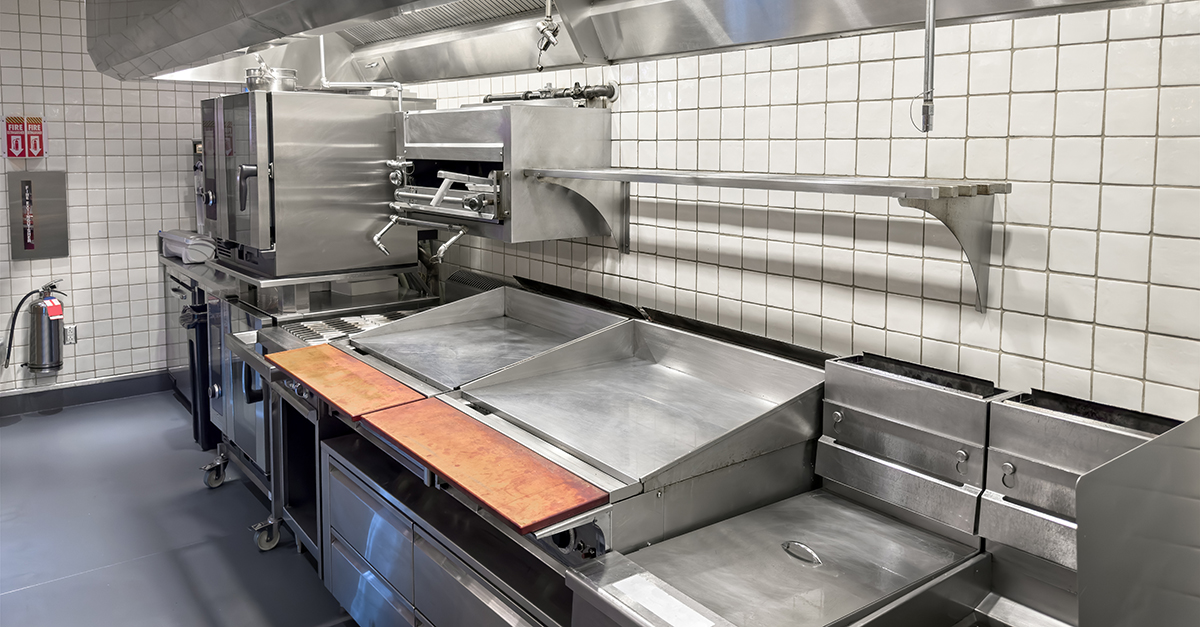In the second week of October 1871, the Great Chicago Fire took the lives of approximately 300 people and left more than 100,000 homeless. In commemoration of this tragedy, in 1922, the National Fire Protection Association (NFPA) named the second week of October Fire Prevention Week. This week and the entire month of October—dedicated as Fire Safety Awareness Month—offer a timely reminder to examine a crucial yet often overlooked area frequently responsible for commercial kitchen fires: the exhaust system.
Wherever meals are served, commercial kitchens present a unique set of fire risks, particularly the hood. Grease-laden vapors, high-temperature equipment, and nonstop food preparation all contribute to a volatile environment. When cleaning and maintenance are neglected, those risks escalate quickly.
For those responsible for maintaining the building’s safety and operations, the mandate is clear: exhaust systems must be professionally cleaned, inspected, and maintained for code compliance and to protect life, property, and operational continuity.
A maintenance priority with high ROI
According to the NFPA, cooking equipment is the leading cause of fires in food service facilities, accounting for nearly 61% of reported incidents. These fires don’t just threaten restaurants; they
impact any facility with a commercial kitchen, including universities, day care centers, event venues, airports, hospital cafes, and beyond.
Grease accumulates inside the hood system, filters, ducts, and rooftop fans. Left untreated, this buildup becomes highly combustible. Even as little as 1/8 inch of grease is enough to warrant
immediate cleaning, per NFPA Standard 96 12.6.1.1.4 (2024 Edition).
For many facilities, the cost of professional exhaust cleaning is negligible—often less than 1% of an organization’s revenue—a small price to pay for preventing incidents that could lead to catastrophic losses. More importantly, the practice of regular exhaust system maintenance fosters a culture of accountability and care, where safety and operational excellence are inextricably
linked. Alternatively, the consequences of ignoring this issue are far-reaching: expensive property damage, extended downtime, potential injuries, higher insurance premiums, and even loss of operating licenses.
Real-world example: Hilton Inn fire
Sadly, one need not look far to understand the real-world cost of neglecting exhaust system maintenance. In 2020, a fire that started in the kitchen exhaust system of the Hilton Garden Inn in Portland, Maine, spread rapidly through the ducts and onto the roof, resulting in more than US$1 million in damages.
The hotel was forced to shut down its kitchen and several floors, resulting in weeks of lost revenue, canceled bookings, and reputational harm. Events like this underscore why hood and duct cleaning is not just a regulatory requirement; it’s a business continuity investment.
This fire didn’t start because of faulty wiring or a rare accident; it was due to grease buildup in the kitchen exhaust system, a preventable issue with routine cleaning. The Hilton incident underscores the financial and operational fragility of commercial facilities when fire safety protocols are not followed. For cleaning and maintenance professionals, it’s a powerful reminder: Neglecting exhaust system maintenance can turn a minor hazard into a multi-million-dollar crisis.
Fire Safety Awareness Month matters
October is an ideal checkpoint for facility and operations teams to audit kitchen exhaust systems, schedule certified hood and duct cleanings, ensure compliance with NFPA 96 and local fire codes, and refresh staff training on fire response protocols.
This month is not just about awareness— it’s about action. Cleaning and maintenance professionals play a pivotal role in implementing and upholding these safety standards across commercial kitchens.
Exhaust cleaning for IAQ
A properly cleaned exhaust system not only reduces fire risk but also improves kitchen ventilation, extends equipment’s lifespan, and promotes healthier indoor air quality (IAQ). Key exhaust areas that demand routine attention include:
- Hoods and filters: These exhaust system parts are first-line grease collectors and should be degreased regularly.
- Ductwork: Although they are difficult to access, ducts are highly flammable and must be cleaned with specialized equipment to eliminate fire hazards.
- Rooftop fans: These fans are essential for airflow but prone to dangerous buildup if they are not included in the cleaning cycle.
Partnering with certified commercial hood cleaning professionals to maintain these areas ensures the use of proper techniques, documentation, and frequency based on cooking volume and system type.
Building a year-round safety culture
Fire safety in food service environments is not a once-a-year task. It requires continuous vigilance and collaboration between facility managers, janitorial teams, third-party vendors, and kitchen
staff. Here are a few best practices:
- Conduct quarterly fire safety meetings with operations and cleaning teams.
- Keep inspection logs and maintenance schedules meticulously updated.
- Foster cross-departmental communication to enable prompt identification and resolution of hazards, reinforcing a robust safety culture throughout the facility.
- Verify that cleaning partners adhere to NFPA protocols and possess the necessary certifications.
As we observe Fire Safety Awareness Month, facility and maintenance professionals have an opportunity to lead. Make this October the start of smarter inspections, stronger vendor partnerships, and stricter adherence to fire safety standards in your building’s food service operations.
When safety is prioritized, everything else—from compliance to performance—follows.



